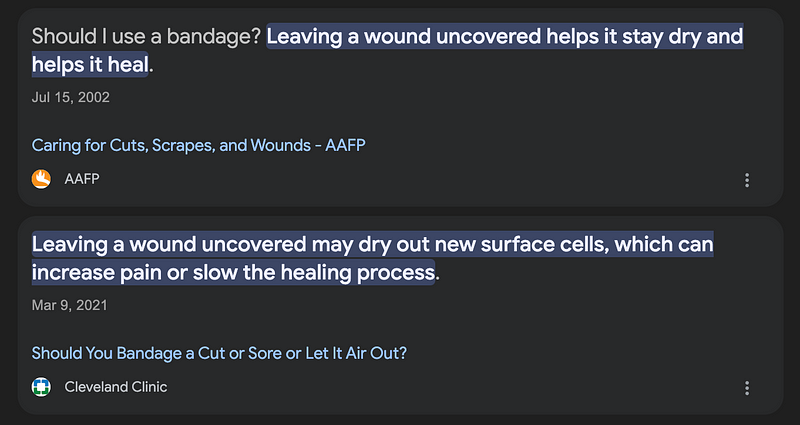Understanding Wound Healing: Covered vs. Uncovered Cuts
Written on
Chapter 1: The Evolution of Wound Care Advice
Do cuts heal more effectively when they are covered? This question has seen a shift in responses over the years, and the answer may surprise you.

“Now, keep this covered with the bandage until the next study says to take it off, okay?” Photo by CDC on Unsplash
Most people can recall their childhood falls: the sudden pain, tears, comforting words from parents, the careful cleaning of the scrape, followed by the delightful feeling of a colorful bandage. Did anyone else have special “cool bandages” reserved for the worst injuries?
After a couple of days, the healing cut may start to itch, leading to the temptation to remove the bandage and allow the wound to breathe. But is it advisable to do so prematurely?

Searching for answers online yields conflicting advice.
- Site 1: “Leave it uncovered; dryness is beneficial!”
- Site 2: “Keep it covered; dryness is detrimental!”
What’s the reality?
Section 1.1: The Healing Process Explained
To understand how wounds heal, we first need to appreciate the remarkable capabilities of our skin.
Minor cuts typically progress through three key stages of healing. The initial phase is the formation of a scab, which occurs immediately after the injury and lasts for about 2 to 5 days. The primary purpose of this scab is to create a barrier against potential infection.
Blood contains crucial elements such as platelets and clotting factors. Platelets, tiny cell fragments in our bloodstream, remain inactive until a vessel is damaged. When bleeding occurs, platelets adhere to the wound’s edges and release proteins that attract more platelets, forming a protective plug to halt bleeding and seal the wound.
The dried mass of platelets, along with trapped red blood cells, forms the scab.
As we move to the second stage—regrowth—cells beneath the scab create a supportive structure known as granulation tissue. This temporary, pink tissue is softer and more delicate than surrounding skin, remaining in place for several weeks.
Over time, the skin regenerates from the wound's edges, gradually replacing most of the granulation tissue. In larger wounds, some of this tissue may remain, resulting in a scar.
The Science of Scarring
Understanding why scars persist can shed light on the healing process.
Chapter 2: The Role of Bandages in Healing
The video discusses whether wounds heal faster when covered or left exposed, providing insights based on recent research.
Views on wound treatment have evolved significantly over the past two decades. Initially, the American Academy of Family Physicians advocated for keeping wounds exposed and dry, suggesting that this approach would minimize bacterial growth. However, this viewpoint has shifted. Current medical advice indicates that if a wound is thoroughly cleaned at the outset, maintaining moisture is preferable for quicker cell regeneration. Bandages effectively protect the wound from dirt while preserving moisture.
Some past claims from companies like Johnson & Johnson suggested that covered wounds heal "up to twice as fast," but these assertions came from unpublished research. Contrarily, several peer-reviewed studies indicate that covered wounds indeed heal more swiftly, enabling a moist, resilient scab to form and facilitating faster recovery beneath. If a wound remains clean, leaving it uncovered does not significantly increase infection risk, though cell regeneration may be slower.
Section 2.1: Steps for Effective Wound Care
Regardless of whether it’s you or someone else with a cut, the treatment steps are straightforward:
- Clean the wound gently with water; there’s no need for harsh antiseptics like hydrogen peroxide.
Why Hydrogen Peroxide Shouldn’t Be In Your First Aid Kit
While it may seem beneficial, hydrogen peroxide can hinder the healing process.
- Apply a bandage to keep the scab moist and prevent it from drying out too quickly.
- Avoid picking at the scab, as this can damage healthy tissue. However, once the scab begins to flake, it’s fine to encourage it to come off with warm water.
- Monitor for signs of infection, such as increased pain, swelling, redness, pus, or red streaks. If any of these symptoms appear, consult a doctor immediately.
- Even after the scab detaches, the wound continues to heal underneath.
The healing process can extend for months, as collagen scaffolds are gradually replaced by new tissue. While scars may not disappear entirely, they often fade over time.
Science Monday: Why Do Scars Persist Despite Cell Regeneration?
Discover how quickly our bodies replace cells and why scars remain even after new skin forms.
In summary, cuts and scrapes are unavoidable, but proper care can facilitate quicker healing and minimize scarring. Wounds require oxygen for healing, but this is supplied by the blood, meaning there's no need to expose them to the air. Covering a wound helps keep cells moist and promotes a faster recovery.
And let’s not forget the most important element in recovery: love! Hugs and support are vital components of the healing journey for both children and adults.
This video explores the ongoing debate about the best practices for wound treatment: scabs versus bandages.